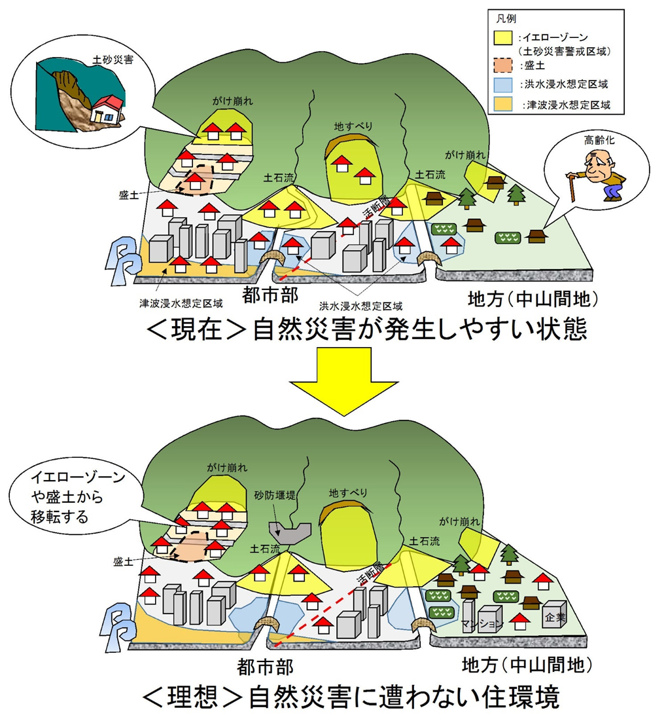Activities
Project
Understanding the historical transition of disaster potential [Division of Natural disaster group]
We will evaluate the long-term damage risk of sediment and flood inundation, and clarify various conditions such as the geology and topography of places that are assumed to be high risk. Based on this, we will establish a process to extract areas where there is a risk of sediment and flood inundation using satellite remote sensing, UAV, etc. In the process, we will clarify the movement characteristics of sediment and propose a method to estimate the sediment supply potential.

Support for formulating flood damage timelines for medical and nursing care facilities [Divisions of Risk Management, Division of Hygiene and Medical Care]
We have conducted evacuation drills assuming flood damage at medical and nursing care facilities in the Koto River basin in Ube City, and analyzed the evacuation process. On the other hand, in the heavy rain disaster in the Kyushu region in July 2020, many victims occurred at nursing homes where evacuation plans had been formulated. Therefore, we conducted interview surveys of facilities that suffered flood damage and interview surveys of facilities that coordinated secondary evacuations. Based on the knowledge obtained the interview surveys and past research results, we provided support for the formulation of effective flood evacuation plans. Specifically, based on the lessons learned from the heavy rain disaster in western Japan in 2018 and the Typhoon No.19 in 2019, we supported the formulation of a flood evacuation plan that (1) secures time for patients and facility users to evacuate safely, and (2) allows medical and nursing care activities to continue stably even after evacuation. In doing so, we utilized the knowledge of flood disaster prevention possessed by researchers in the Division of Risk Manegement and the knowledge of health and nursing care possessed by the Division of Hygiene and Medical Care.
In addition, from January to March 2021, we conducted a survey of accommodation facilities in Ube City and held a meeting to report research results with Ube City officials in order to consider disaster evacuation shelter functions to strengthen disaster resilience in basic local governments.
Support and model development for regional disaster prevention and welfare community building through "Community Disaster Mitigation Nurse Training" [Division of Hygiene and Medical Care, Divisions of Risk Management]
As a disaster prevention model development project that assumes flood damage, we are working to support the creation of a safe and secure community for each school district through cooperation and mutual assistance with local residents and the government using Ube City as a field.
The "Community Disaster Mitigation Nurse Training" is aimed at nurses who live or work in elementary school districts, and is held with the participation and cooperation of local residents to create a community that integrates disaster prevention and welfare. The first training was held in Shimonoseki City, Yamaguchi Prefecture, from September to December 2021. Using the process and results of this training as a reference, the second training was held in Ube City from July to October 2022 after modifying the project plan to aim for community building.
This project is planned based on an implementation research framework that clarifies strategies for establishing Evidence-Based Intervention (EBI) in the field, with the aim of developing a model for creating a community for disaster prevention and welfare that can be horizontally deployed to other regions.
※Community Disaster Mitigation Nurse:
The Japan Society of Disaster Nursing started training instructors in 2019. During the calm period of disasters, based on the disaster prevention plan of the region and district, Community Disaster Mitigation Nurses work with administrative officials and residents on disaster mitigation activities that make use of our nursing expertise. In the event of a disaster, they play a role in supporting the health and lives of residents in the affected areas.
Establishment of networks with overseas researchers involved in disaster prevention [Division of International Disaster Prevention]
Starting in March 2021, we hold an annual “International Alumni Online Seminar on Disaster Prevention and Environment” once a year in order to establish a network of overseas researchers engaged in disaster prevention, mainly international students who have graduated from Yamaguchi University, and are creating a system that allows many of the participants to communicate with each other through SNS. In particular, we have built close relationships with East Timorese researchers, including an emergency debriefing session on the sediment disaster that occurred in East Timor in April 2021 and subsequent follow-up.
In addition, we continuously hold YU-YCL symposiums with University College London (UCL) in the UK to exchange opinions on various themes related to disaster prevention and mitigation.
Furthermore, in the JSPS bilateral exchange project joint research, the leader of the Division of International Disaster Prevention is conducting joint research with Riau University in Indonesia on "Establishment of the coastal peat sediment dynamics" and is working on clarifying the mechanism of coastal erosion of Indonesian peatlands.

